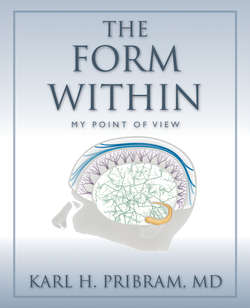Читать книгу The Form Within - Karl H Pribram - Страница 22
На сайте Литреса книга снята с продажи.
Brain Shapes: Gestalts
ОглавлениеNot long afterward, the famous German Gestalt psychologist Wolfgang Köhler told me about his “direct current” hypothesis as the basis for cortical processing in vision. Here was the holistic “something” which I could relate to the results of Gerard’s neurophysiological experiment. Köhler and his fellow Gestalt psychologists believed that instead of working through the connections between neurons, our perceptions are reflected in electrical fields in the brain that actually have a geometrical shape resembling the shape of perceived objects. This view is called “geometric isomorphism” (iso = same and morph = shape). The Gestalt psychologists believed, for example, that if one is looking at a square—a geometrical shape—the electrical fields in one’s brain also have a square geometrical shape. Our brain representations will literally “picture” the significant environment of the organism, or at least caricature the Euclidian shape of the object while we are observing it.
In the mid-1950s, Köhler enthusiastically demonstrated his electrical fields to me and to my PhD students Mort Mishkin from McGill University in Montreal (later to become head of the Laboratory of Neuropsychology at the United States Institutes of Health) and Larry Weiskrantz from Harvard (later to become head of the Department of Experimental Psychology at Oxford University) during one of his visits to my laboratory at the Institute of Living, a mental hospital in Hartford, Connecticut. Köhler showed us just how the putative direct current (DC) electrical activity could anatomically account for visual and auditory perception.
Köhler would drive from Swarthmore College in Pennsylvania, where he was teaching, to my laboratory. We would put monkeys in a cage and take them to MIT, where we had access to the necessary auditory-stimulus control equipment to do our experiments. At MIT he and I were recording changes in direct current fields recorded from the auditory cortex of monkeys while we briefly turned on a loudspeaker emitting a tone.
On other occasions we would meet in New York City to work with patients who were being operated upon for clinical reasons and who gladly gave their consent to serve as subjects. In these experiments, Köhler and I would display a piece of reflective white cardboard in front of the subjects’ eyes while we made DC electrical recordings from the back of their brains, where the cortex is located that receives the nerve tracts from the eye. Indeed, as Köhler had predicted, we found that both monkey brains and human brains responded with a DC shift when we turned on a tone or displayed a white cardboard.
